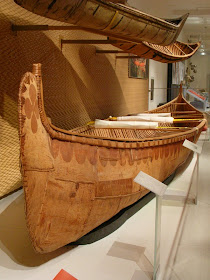In any event, the museum is FREE on Wednesday afternoons from 4:30 to the 5:30 closing - a perfect amount of time to peruse this small gallery on the museum's main floor. So I went down to specifically examine their small collection of canoes and other artifacts.

General view of canoe exhibit
The first canoe on the wall had some very interesting features that I had never seen before. One of the first things I noticed was a partial length, thin second outwale nailed to the original root lashed outwales. Information on whether this was a repair to a cracked outwale or part of the original design wasn't provided. You can just make it in the enlarged version of the photo below.

Algonkin Canoe
Late 19th century
Area of Origin: Northeast Ontario; White Bear Lake
NS23087
Also interesting was that the stem area wasn't lashed, but rather the bark nailed flush into the stempiece and them sealed with gum. This seems like a more simple and watertight solution to lashing, especially since it is the stem area of my canoe where the water perpetually leaks from. If I ever get around to building a 2nd canoe, I think this'll be the route I take. Didn't notice it right away, but underneath the hull was what looked like a short wooden keel nailed to the bottom of the boat. Not sure if it was there to stiffen the hull as a repair job or made to improve the tracking of the boat on open water. Either way, this is the first time I've ever seen one on a birchbark canoe.


Nailed bark to stem; Keel nailed to underneath of hull
Of course, the real eye-catcher of the display is the huge 36ft Montreal Freight canoe built by César Newashish (of the famed NFB film, Cesar's Bark Canoe). I've seen a 24 ft North Canoe built by him at the Canadian Canoe Museum, but this one was a monster in comparison - so huge, I couldn't get a proper lateral shot. It is being supported with straps and foam strips across the gunwales. This canoe is on the ROM's Audio Tour which provides some extra (albeit hokey) information about the boat.

Newashish Freight Canoe
A closer look on the gunwhale cap shows a repair where a piece had cracked - basically a scarf joint that is pegged into position. Useful to know if the caps ever break.

Repair to gunwale cap
Another thing I noticed about this canoe was the complete absence of any gum on the seams. It would seem that that this canoe was probably never built to be used but rather displayed as a museum piece. Either way, the sheer scale and time invested in making one of these crafts is a testament to the skills and patience of the builder.

View from the other end - no gum anywhere

Just did a quick visit of ROM myself and didn't even know about this exhibit -- too bad.
ReplyDeleteRegarding the scarfed gunwale cap -- it may have been original construction, not a repair. At the Penobscot Marine Museum (Searsport, ME) we recently acquired a Penobscot bark canoe, built 1850-60, with similar scarfed caps and they appear to be original. At least, bark canoe builder/restorer Steve Cayard didn't identify them as repairs.
Thanks for the info Bob. I assumed it was a repair job as the museum staff were not helpful. I suppose since the caps don't provide any real strength to the boat but serve to protect the gunwale lashings, a scarfed construction would suffice if the wood stock wasn't long enough.
ReplyDeleteIf you're ever back at the ROM, the exhibit is tucked away in a remote corner of the first floor and is called The Daphne Cockwell Gallery. Definitely worth a walk through.